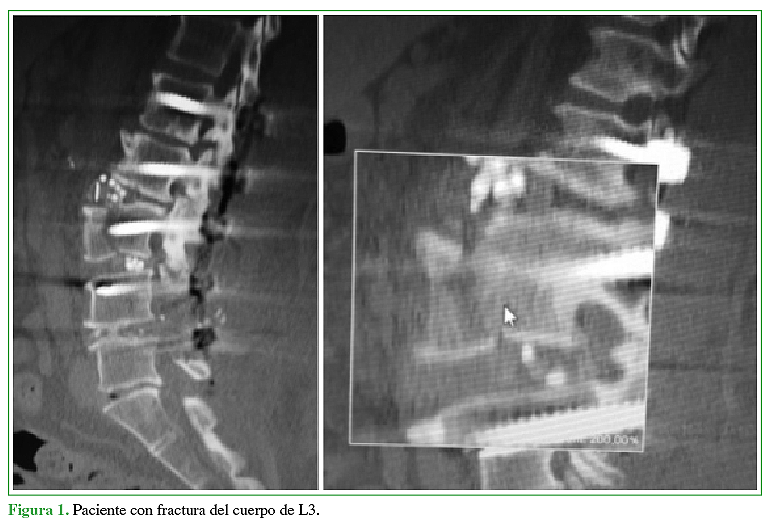Early complications of the minimally invasive lateral lumbar spine surgery: a 50-case series
Main Article Content
Abstract
Materials and Methods: We conducted a retrospective study in 50 patients that underwent lateral retroperitoneal interbody fusion using a MISS technique between September 2015 and April 2018. The assessed parameters were: demographic, radiological and surgical data, and all the early complications encountered.
Results: A total of 76 cages were used: 5 at L1-L2 level; 33 at L2-L3 level; 34 at L3-L4 level; and 4 at L4-L5 level. Out of the 50 patients, 25 underwent fusion only at 1 level, 24 underwent fusion at 2 levels, and 1 underwent fusion at 3 levels. A total of 21 complications were encountered: 4 major complications, and 17 minor complications. The longest surgical time (90 minutes) and the highest complication rate were observed within cases 1-16 (12 patients). Thereafter, these parameters proportionately decreased until they reached a minimum of 3 complications within cases 34-50.
Conclusions: The main complications occurred in the surgical access, and their incidence decreased as the surgeon's experience increased and as the surgical time shortened.
Level of Evidence: IV
Downloads
Metrics
Article Details
Manuscript acceptance by the Journal implies the simultaneous non-submission to any other journal or publishing house. The RAAOT is under the Licencia Creative Commnos Atribución-NoComercial-Compartir Obras Derivadas Igual 4.0 Internacional (CC-BY-NC.SA 4.0) (http://creativecommons.org/licences/by-nc-sa/4.0/deed.es). Articles can be shared, copied, distributed, modified, altered, transformed into a derivative work, executed and publicly communicated, provided a) the authors and the original publication (Journal, Publisher and URL) are mentioned, b) they are not used for commercial purposes, c) the same terms of the license are maintained.
In the event that the manuscript is approved for its next publication, the authors retain the copyright and will assign to the journal the rights of publication, edition, reproduction, distribution, exhibition and communication at a national and international level in the different databases. data, repositories and portals.
It is hereby stated that the mentioned manuscript has not been published and that it is not being printed in any other national or foreign journal.
The authors hereby accept the necessary modifications, suggested by the reviewers, in order to adapt the manuscript to the style and publication rules of this Journal.
References
2. Rodgers WB, Gerber EJ, Patterson J. Intraoperative and Early Postoperative Complications in Extreme Lateral Interbody Fusion. Spine 2011;36:216-23
3. Youssef JA, McAfee PC, Patty CA, Raley E, Debauche S, Shucosky E, et al. Minimally invasive surgery: lateral approach interbody fusion: results and review. Spine 2010;35:S302–11
4. Tohmeh AG, Rodgers WB, Peterson MD. Dynamically evoked, discrete-threshold electromyography in the extreme lateral interbody fusion approach. J Neurosurg Spine. 2011;14:31–7.
5. Lee YP, Regev GJ, Chan J, Zhang B, Taylor W, Kim CW, et al. Evaluation of hip flexion strength following lateral lumbar interbody fusion. Spine J. 2013;13:1259–62.
6. Cahill KS, Martinez JL, Wang MY, Vanni S, Levi AD. Motor nerve injuries following the minimally invasive lateral transpsoas ap- proach. J Neurosurg Spine. 2012;17:227–31.
7. Knight RQ, Schwaegler P, Hanscom D, Roh J. Direct lateral lumbar interbody fusion for degenerative conditions: Early complication profile. J Spinal Disord Tech. 2009;22:34–7.
8. Bendersky M, Solá C, Muntadas J, et al. Monitoring lumbar plexus integrity in extreme lateral transpsoas approaches to the lumbar spine: a new protocol with anatomical bases. Eur Spine J 2015;24:1051-7.
9. Assina R, Majmundar NJ, Herschman Y, Heary RF (2014) First report of major vascular injury due to lateral transpsoas approach leading to fatality. J Neurosurg Spine 21(5):794–798.
10. Santillan A, Patsalides A, Gobin YP. Endovascular embolization of iatrogenic lumbar artery pseudoaneurysm following extreme lateral interbody fusion (XLIF) Vasc Endovascular Surg. 2010;44:601–3.
11. Deukmedjian AR, Le TV, Dakwar E, Martinez CR, Uribe JS. Movement of abdominal structures on magnetic resonance im- aging during positioning changes related to lateral lumbar spine surgery: a morphometric study. J Neurosurg Spine. 2012;16: 615–23.
12. Le TV, Baaj AA, Dakwar E, Burkett CJ, Murray G, Smith DA, et al. Subsidence of polyetheretherketone intervertebral cages in mini- mally invasive lateral retroperitoneal transpsoas lumbar interbody fusion. Spine 2012;37:1268–73.
13. Marchi L, Abdala N, Oliveira L, Amaral R, Coutinho E, Pimenta L. Radiographic and clinical evaluation of cage subsidence after stand- alone lateral interbody fusion. J Neurosurg Spine. 2013;19:110–8.
14. Brier-Jones JE, Palmer DK, Ǐnceoǧlu S, Cheng WK. Vertebral body fractures after transpsoas interbody fusion procedures. Spine J. 2011;11:1068–72.
15. Kepler CK, Sharma AK, Huang RC. Lateral transpsoas interbody fusion (LTIF) with plate fixation and unilateral pedicle screws: a preliminary report. J Spinal Disord Tech. 2011;24:363–7.
16. Daffner SD, Wang JC. Migrated XLIF cage: case report and discussion of surgical technique. Orthop. 2010,33:518.
17. Towers WS, Kurtom KH. Stand-alone LLIF lateral Cage Migration: Acase report. Cureus 2015, 7(10) e347.
18. Dakwar E, Le TV, Baaj AA, Le AX, Smith WD, Akbarnia BA, et al. Abdominal wall paresis as a complication of minimally invasive lateral transpsoas interbody fusion. Neurosurg Focus. 2011;31: 1-4

